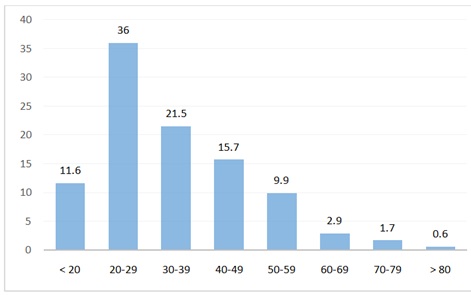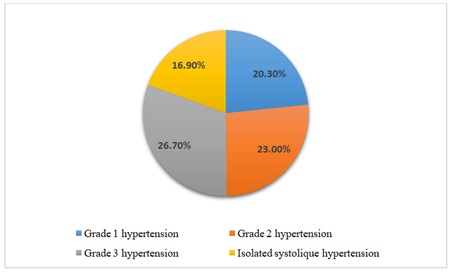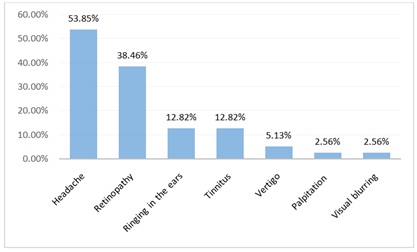
Secondary Arterial Hypertension to Primary Glomerulopathies in Senegal
*Corresponding Author(s):
Ahmed Tall LemrabottNephrology Department, Aristide Le Dantec University Hospital, Dakar, Senegal
Email:ahmedtall35@hotmail.com
Abstract
Introduction: Hypertension is a major public health problem. Parenchymal nephropathy is the leading cause of secondary hypertension, with glomerulopathy leading the way. In sub-Saharan Africa, little data are available on hypertension secondary to primary glomerulopathy.
Aims: To describe the epidemiological, diagnostic, therapeutic and progressive aspects of hypertension during primary glomerulopathy and to investigate the factors associated with the occurrence of this hypertension.
Patients and methods: This was a seven-year descriptive and analytical retrospective study carried out within the Nephrology Department of the Aristide Le Dantec University Hospital. We collected epidemiologic, clinical, paraclinical, therapeutic and progressive data from records of patients with hypertension caused by primary glomerulopathy.
Results: We included 172 patients. The prevalence of hypertension was 46%. The mean age was 33.9±13.7 years and the sex ratio was 2.07. The mean systolic blood pressure was 158.93±21.57mmHg. The mean diastolic blood pressure was 98.23±14.8mmHg. The most frequent HBP grade was grade II, noted in 36% of cases. The most observed sign of hypertension was headache in 53.8% of cases followed by acute lung oedema in 38.5% of cases. Renal oedema was noted in 80.8% of cases. End-stage renal disease was found in 45.9% of cases. Nephrotic syndrome was noted in 62.7% of cases. Left ventricular hypertrophy was noted in 42.8% of cardiac ultrasound cases. Focal and Segmental Glomerulosclerosis (FSGS) was the most frequent lesion observed in 48.7% of cases. Angiotensin Converting Enzyme inhibitors (ACE inhibitors) were prescribed in 79% of cases. Combination therapy was prescribed in 64.5% of cases. Triple therapy was prescribed in 25% of cases. The evolution of hypertension at 1 month was favourable in 29.8% of cases and unfavourable in 47% of cases; at 12 months, this was favourable in 84.6% of cases and unfavourable in 11.5% of cases. Factors associated with the occurrence of hypertension were hypoalbuminemia below 30 g/L (P=0.018) and stage 1 chronic kidney disease (P=0.0001).
Conclusion: Hypertension secondary to glomerulopathy wascommon in our study. Nephrotic syndrome wasthe most commonly observed glomerular syndrome. The histological lesion most involved was FSGS. This hypertension can develop on its own account, leading to complications, hence the importance of screening for it as soon as possible.
Keywords
Hypertension; Primary Glomerulopathies; Focal Segmental Glomerulosclerosis; Senegal
Introduction
Hypertension is a major public health problem. It affects one billion people worldwide and is responsible for 9 million deaths per year [1,2]. In Africa, the prevalence of hypertension is 46% [3] and in Senegal it is 24% [4]. It is either essential or secondary to a known cause. The most frequent causes of secondary hypertension are parenchymal nephropathies, with primary glomerulopathies leading the way, responsible for hypertension in 30% of cases [1].
In Africa, there are few data on secondary hypertension and particularly those related to a glomerular cause. Based on this observation, we therefore conducted this study with the objectives of describing the epidemiological, diagnostic, therapeutic and progressive aspects of hypertension secondary to primary glomerulopathies and to search for the factors associated with the occurrence of this hypertension.
Patients and Methods
This was a retrospective descriptive and analytical study that took place over a period of seven years (January 1, 2010 to January 1, 2017) in the nephrology department of Aristide Le Dantec University Hospital in Dakar (Senegal). We included all the patients hospitalized or followed in consultation for primary glomerulopathy and who presented with hypertension. Patients with a history of hypertension or hypertension secondary to another cause were not included in the study.
We collected epidemiological data such as age, gender, clinical data including medical and surgical history, blood pressure, weight, height, diuresis, urine test results, biological data such as serum creatinine, blood count, blood ionogram, serum protein electrophoresis, cholesterolaemia, 24h proteinuria, Addis count, radiological data with the results of renal ultrasound, electrocardiogram and cardiac ultrasound and histologic data represented by histologic examination of renal biopsy specimens. We also collected the therapeutic means used both for the treatment of hypertension and for that of glomerulopathy as well as the evolving modalities of this hypertension at 1 month, 3 months, 6 months and 12 months.
Hypertension was defined as blood pressure greater than or equal to 140/90mmHg [5] and was classified according to the WHO classification [5]. Resistant hypertension is defined by blood pressure not controlled in consultation and confirmed by measurements outside the doctor’s office, despite a therapeutic strategy comprising adapted hygiene and dietetic rules and antihypertensive triple therapy (thiazide diuretic, Renin-Angiotensin-System (RAS) blocker and calcium channel blocker), for at least 4 weeks, at the optimal dose [6]. Primary glomerulopathy was defined as any glomerulopathy without a cause identified at the end of clinical and paraclinical investigations. Chronic kidney disease was defined and classified according to the KDIGO criteria [7]. Glomerular Filtration Rate (GFR) was calculated according to the MDRD formula. The favourable outcome was defined as a controlled blood pressure of less than 140/90mmHg. The unfavourable outcome was defined by at least one of the following criteria: resistant hypertension, persistence of hypertension, worsening of high blood pressure, onset of hypertension-related complications or death.
Statistical analysis was performed with SPSS software version 18.0. The descriptive study was carried out with the calculation of frequencies and proportions for the qualitative variables and the calculation of means for the quantitative variables. Chi-squared and Fisher’s tests were used to compare frequencies with a significance level (p≤0.05).The Local Ethical Committee has approved this study.
Results
During the study period, 368 patients were followed for primary glomerulopathy and 172 of them presented with hypertension, for a prevalence of hypertension of 46%. The mean age of the patients in the study was 33.9±13.7 years and 36% of them were between 20 and 29 years old (Figure 1). The sex ratio was 2.07 (116 men and 56 women).
 Figure 1: Distribution of patients by age.
Figure 1: Distribution of patients by age.
The mean systolic blood pressure was 158.9±21.6mmHg and that of diastolic blood pressure was 98.2±14.8mmHg. Grade III hypertension was the most common (36%). Figure 2 shows the distribution of patients according to the grade of hypertension. The mean BMI was 22.6±5kg/m2 and obesity was noted in one patient. The mean diuresis was 1232±632 ml/24h and 13% of the patients were oligo-anuric. Examination of the urine strips revealed 3+ proteinuria in 47% of cases and 3+ haematuria in 25% of cases.
 Figure 2: Distribution of patients according to hypertension grade.
Figure 2: Distribution of patients according to hypertension grade.
Hypertension was symptomatic in 22.6% of cases and the main clinical manifestations were headache (53.8%), hypertensive retinopathy (38.5%) and acute lung oedema (38.5%). The clinical signs of hypertension are summarized in figure 3. The clinical signs of glomerulopathies were dominated by renal-type oedema observed in 80.8% of cases. Chronic uraemia was noted in 25% of cases.
 Figure 3: Distribution of patients according to the signs of hypertension.
Figure 3: Distribution of patients according to the signs of hypertension.
The mean haemoglobin level was 9.4±3.2g/dL and it was less than 12g/dL in 73% of cases. The mean serum creatinine was 85.25±97.8mg/Land it was greater than 12 mg/Lin 81% of cases. End-Stage Renal Disease (ESRD) was found in 45% of patients and stage 1 CKD in 18% of patients. The mean proteinemia was 55.75±12.6g/Land it was less than 60g/Lin 64% of cases. The mean serum albumin was 23.8±9.7g/Land was less than 30g/Lin 74% of cases. The mean serum sodium was 134.4±6.73mmol/Land hyponatremia was noted in 44% of cases. The mean serum potassium was 4.62±1.15mmol/L and hyperkalaemia was noted in 40% of cases. The mean cholesterolaemia was 2.92±1.6g/L and 64% of the patients presented with hypercholesterolemia. The mean value of LDL cholesterol was 1.83±1.4g/L, and hyper-LDL-cholesterolaemia was noted in 38% of cases. The mean proteinuria was 5.26±4.62g/24h and it was greater than 3g/24h in 65% of cases.
Glomerulopathies were classified into glomerular syndromes and nephrotic syndromes,which werethe most commonly observed (63%), followed by chronic glomerulonephritis (36%). Segmental and Focal Glomerulosclerosis (SFGS) was the predominant histologic lesion, noted in 48.7% of cases. The distribution of patients according to histological lesions is shown in table 1.
|
Histologicallesions |
Number (N=76) |
Percentage |
|
Focal Segmental Glomerulosclerosis (FSGS) |
37 |
48,7% |
|
Minimal Change Disease (MCD) |
11 |
14,5% |
|
Membranous Glomerulo Nephritis (MGN) |
10 |
13,2% |
|
Membrano Proliferative Glomerulo Nephritis (MPGN) |
2 |
2,6% |
Table 1: Distribution of patients according to histologicallesions.
Left ventricular hypertrophy was found in 43% of cases on cardiac ultrasound.
The main therapeutic methods used for the treatment of hypertension were ACE inhibitors (79%), loop diuretics (76%), low-sodium diet (68%) and calcium channel blockers (47%). Dual therapy (ACE inhibitor + diuretic) was prescribed in 64% of cases and triple therapy (ACE inhibitor + diuretic + calcium channel blocker) was prescribed in 25% of cases. Table IV summarizes the different treatments for hypertension.
After 1 month of treatment, the outcome was favourable with controlled blood pressure in 30% of cases. At 3 months of treatment, only 19% of patients had their blood pressure controlled; this percentage was even lower at 6 months of treatment (14.5%). However, the outcome after 12 months was favourable in 84.6% of cases. During follow-up, we noted no cases of death.
Factors associated with the onset of hypertension were hypoalbuminemia less than 30g/L (p=0.018) and stage 1 CKD (p=0.0001).
Discussion
In our study, the prevalence of hypertension secondary to glomerulopathies was 46%. Our results are similar to those noted in the study by Flayou et al. and in that of Modugumudi et al., in which the prevalence of hypertension was 40% [8] and 41.6% [9], respectively. Our study confirms the data in the literature, which classifies primary glomerulopathies at the top of the list of the aetiologies of secondary hypertension [1,10].
The mean age of the patients in our study was 33.9±13.7 years. Similar results were noted in the Al Wakeel study where the mean age was 34.6 years [11], as well as in the Quieroz study where the mean age was 37.9 years [12]. Our study corroborates the fact that hypertension secondary to glomerulopathy is more common in young adults [2].
Acute pulmonary oedema was observed in 38.5% of our patients, whichcould be explained by the water and sodium retention thatconstitutes one of the pathophysiological mechanisms of hypertension in Glomerulopathy [13].
In our study, renal failure was noted in 81.2% of cases. This prevalence is high compared to the studies by Al Wakeel and Flayou where the prevalence was 41.6% [11] and 55.7% [8], respectively. This difference in results could be explained by the delay in consulting the patients in our study.
In our study, 62.7% of patients presented with nephrotic syndrome. Quieroz et al., also noted a similar result in their study, with a prevalence of 67.3% [12]. Hypercholesterolemia was noted in 64% of our patients. Similar results were noted in previous studies, particularly in the study by Modugumudi et al., in which hypercholesterolemia was present in 64.2% of cases [9].
The main histological lesion noted in our study was SFGS; in fact, it was present in 48.7% of cases. Our results are different from those observed in previous studies, in particular in the study by Flayou et al., where the prevalence of SFGS was 24.6% [8] and in that of Saada et al. in which 32.6% of patients presented with SFGS [14]. This difference could be explained by ethnic differences and in particular the genetic predisposition linked to a polymorphism and to the existence of two variants (G1 andG2) of the gene encoding APOL1 [15].
The therapeutic measures prescribed for the patients in our study were dominated by ACE inhibitors and loop diuretics, respectively administered in 79% of cases and in 76% of cases. This could be explained by the fact that hypertension secondary to glomerulopathies is due to sodium hydroxide retention and activation of the renin angiotensin aldosterone system [16].
Conclusion
Hypertension secondary to primary glomerulopathies was common in our study. Nephrotic syndrome was the main glomerular syndrome. Histopathological lesions were dominated by SFGS. The occurrence of this hypertension was associated with hypoalbuminemia.
Due to the high frequency of hypertension secondary to glomerulopathies and its potential severity, it appears necessary to implement early detection measures such as the correct measurement of blood pressure in any patient with primary glomerulopathy and performing systematic urine strip analysis in all hypertensive patients.
Conflict of Interest
None
Acknowledgment
Pathology laboratory of Idrissa Pouye General Hospital.
References
- Kearney PM, Whelton M, Reynolds K, Muntner P, Whelton PK, et al. (2005) Global burden of hypertension: Analysis of worldwide data. Lancet 365: 217-23.
- Rimoldi SF, Scherrer U, Messerli FH (2014) Secondary arterial hypertension: When, who, and how to screen? Eur Heart J 35: 1245-1254.
- WHO (2013) A global brief on hypertension: Silent killer, global public healthcrisis: World Health Day 2013.
- National survey on riskfactors for noncommunicablediseases. Preliminary report: Key indicators. Senegal: STEPS Survey
- Guidelines Subcommittee (1999) 1999 World Health Organization international society of hypertension. guidelines for the management of hypertension. J Hypertens 17: 151-183.
- Denolle T, Chamontin B, Doll G, Fauvel JP, Girerd X, et al. (2014) Management of resistant hypertension. Expert consensus statement from the French Society of Hypertension, an affiliate of the French Society of Cardiology. Press Med 43: 1325-1331.
- Kidney Disease: Improving Global Outcomes (KDIGO), CKD Work Group (2013) KDIGO 2012 clinical practice guideline for the evaluation and management of chronic kidney disease. Kidney Int Suppl 3: 1-150.
- Flayou K, Berrada S, Benamar L, Rhou H, Bayahia R, et al. (2016) Profil épidémiologique de l’hypertension artérielle au cours des néphropathies glomérulaires primitives: à propos de 61 cas. Néphrol Ther 12: 343.
- Modugumudi ASN, Venkata PB, Bottla SKV, Kottu R, Nandyala R, et al. (2016) A study of primary glomerular diseases in adults: Clinical, histopathological and immunofluorescence correlations. J Nephropharmacol 5: 91-97.
- Ridao N, Luno J, de Vinuesa SG, Gómez F, Tejedor A, et al. (2001) Prevalence of hypertension in renal disease. Nephrol Dial Transplant 16: 70-73.
- Al Wakeel JS, Mitwalli AH, Tarif N, Alam AA, Hammad D et al. (2004) Spectrum and outcome of primary glomerulonephritis. Saudi J Kidney Dis Transplant 15: 440-446.
- Queiroz AL, Barreto DMS, Da Silva GBJ, Tavares Neto JES, Costa FI, et al. (2015) Pattern,clinical features and response to corticoids of glomerular diseases in a Brazilian population. An analytical cross-sectional study. Sao Paulo Med J 133: 43-50.
- Schorn R, Bleisch J (2013) Syndrome néphrotique de l’adulte. Forum Med Suisse 13: 627-632.
- Saada F, Talbi S, Atrouz F (2015) Contrôle de la pression artérielle au cours des néphropathies glomérulaires primitives: à propos de 153 cas. Ann Cardiol Angeiol 64: 86.
- Okpechi I, Duffield M, Swanepoel C (2012) Primary glomerular diseases: Variations in diseases types seen in Africa and Europe. Port J Nephrol Hypert 26: 25-31.
- Hall JE (2003) The kidney, hypertension, and obesity. Hypertension 41: 625-633.
Citation: Faye M, Lemrabott AT, Keita AI, Faye M, Mbengue M, et al. (2022) Secondary Arterial Hypertension to Primary Glomerulopathies in Senegal. J Nephrol Renal Ther 8: 068.
Copyright: © 2022 Maria Faye, et al. This is an open-access article distributed under the terms of the Creative Commons Attribution License, which permits unrestricted use, distribution, and reproduction in any medium, provided the original author and source are credited.

